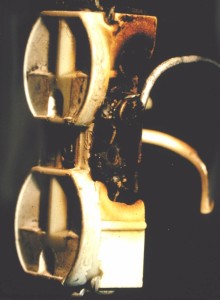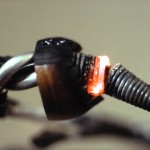The main risk associated with aluminum wiring is fire, which in severe cases has led to loss of life. This risk prompted the US Consumer Product Safety Commission to produce publication 516 – Repairing Aluminum Wiring.
So just how dangerous is aluminum wiring compared to copper wiring? According to CPSC research, the associated risk is 55 times more in a house wired with aluminum!
The cause of fires related to aluminum wiring is increased resistance in the wiring due to increased resistance as a result of aluminum breakdown. The prohibitive cost of hard to find copper wiring during the decade following 1965 was the primary driver for the introduction of cheaper aluminum wiring from the 60’s into the 70’s, making houses built during this period particularly at risk.
There are two properties that make Aluminum less than desirable for electrical connections: High electrical resistance requiring larger diameters to avoid overheating Subject to bending or pressure induced fatigue causing hidden internal break down
Aluminum Wiring – The Early Signs of Dangers
As wiring is not typically available for easy inspection, failure usually occurs suddenly without warning. At best this will provide immediate inconvenience and cost for families of businesses, at worst it can cause devastating loss of property, or even life.
The only warning that aluminum wiring is about to fail can be overheating of switches or face plates, a smell of burning, or intermittent issues with electrical appliances or lighting. At this point the wiring is extremely close to failure and should be inspected and replaced by a qualified electrician.
Aluminum Wiring – The Three Solutions
There are three approved methods of providing a permanent solution to aluminum wiring Copper re-wire COPALUM repair AlumiConn Connectors
Copper re-wiring is the most expensive solution, and a large undertaking for even a modest property. For this reason, most solutions are either COPALUM joins, or AlumiConn connectors.
With a COPALUM join, a short length of copper is joined to the existing aluminum wire at every connection throughout the property, including dimmers, light switches, fixtures, appliances, and junction boxes. A special tool facilitates this permanent repair, however this is not a do it yourself project and requires a fully trained technician to carry out the process.
These repairs are not as expensive as a full re-wire, however the cost remains high and requires the services of a qualified engineer. For this reason, there is one final option – AlumiConn connectors.
AlumiConn connectors use a screw fastening that does not require a special tool, making it a less expensive option – in fact this is the most inexpensive permanent solution recommended by the CPSC.
Please note that there are other connector solutions available at retailers, however only the three options above are approved as permanent safe repair methods.
Due to the inexpensive nature, ease of fitting, and CPSC approval, the AlumiConn has become an extremely popular method of solving the problems associated with aluminum wiring.
The entire process of fitting these connectors is shown in this video
The only tools required are standard electrical hand tools such as wire stripper and a torque screwdriver as the required torque depends on the gauge of the aluminum wire. As previously explained aluminum wiring is subject to internal failure due to compressive stress, it is therefore vital that the correct pressure is used when torqueing the screws, otherwise the repair can be subject to failure.
There are two versions available depending on the wiring installation; a 2-port AlumiConn connector for standard sockets and a 3 port for installations with more wiring.
These connectors offer a secure permanent repair, as authorised by the CPSC. They are one piece units with a hinged lid, and separate ports to ensure safer secure connections. Constructed with dielectric silicone and tin plated lugs with nickel plated screws, they are designed for longevity and reduce instances of corrosion.
A special report on reducing the fire risk in aluminum homes commissioned in 2011 confirms the viability of the AlumiConn solution, stating that there have been no reports of burnouts or failures in any situation where the connector has been used.
A point worth noting is the use of antioxidant. Application of antioxidant to aluminum wiring is not a recommended solution to the overheating dangers associated with this wiring. However, AlumiConn connectors do come pre-filled with antioxidant making them the perfect solution. This point was clarified due to a query from a New Jersey contractor involved in safety measures on a wiring project.
Aluminum Wiring – In Summary
The overheating risks associated with aluminum wiring are well documented and the solutions to this potential killer are clearly laid out by the US Consumer Product Safety Commission. There is very little scope for warnings, the best course of action is proactive works involving the use of AlumiConn
Aluminum was originally used for electrical wiring because it was cheap and still is, compared to copper.
First of all, for a given current or Load, you need a larger diameter wire to properly carry the same current.This is because aluminum has a considerably higher resistance per foot for the same gauge wire than does copper.
This is aluminum’s deadly failing. Aluminum is prone to failure from work hardening. Most of us have heard of airliners that have lost pieces of the plane in flight. That was the result of catastrophic failure from work hardening due to expansion and contraction, stress, and vibration. Without warning, aluminum will fracture and fail.
The same risk exists in your home. Instead of vibration, aluminum is prone to work hardening from heat stresses caused by appliances and other house hold loads being turned on and off. Over time, minute fractures appear in aluminum’s grain structure which further increase the wire’s resistance. The greater resistance causes the wire to get hotter. Hotter wire means more thermal stress and grain separation. It’s a brutal cycle until the wire fails or gets hot enough to burn your house down.
to work hardening from heat stresses caused by appliances and other house hold loads being turned on and off. Over time, minute fractures appear in aluminum’s grain structure which further increase the wire’s resistance. The greater resistance causes the wire to get hotter. Hotter wire means more thermal stress and grain separation. It’s a brutal cycle until the wire fails or gets hot enough to burn your house down.
Opposite to what people have said, aluminum doesn’t corrode in air. This is because of the skin of aluminum oxide which forms on aluminum’s surface and protects it from further corrosion. You know aluminum oxide as anodized aluminum: a ceramic-hard coating on aluminum to protect it.


Comments are closed.